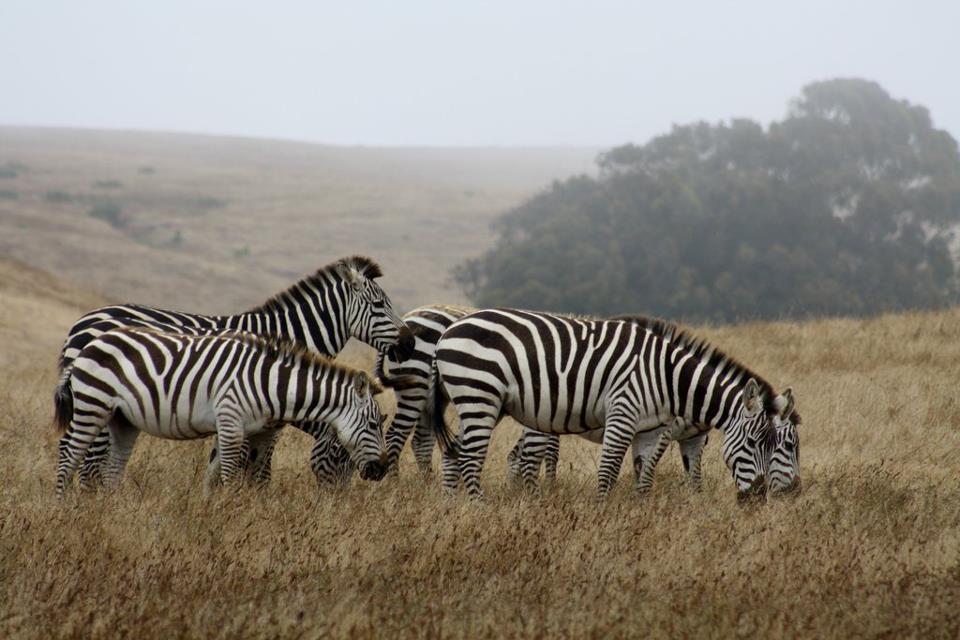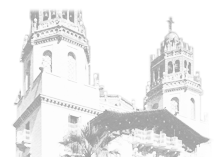Traveling the winding ranch road to Hearst Castle, guests once passed through fenced fields populated with many species of exotic wild animals freely roaming over the hillsides as though they were native to this land. It was an amazing sight, featuring an ever-changing collection of animals—like American bison, Rocky Mountain elk and zebras.
Animal Hill
 Formally named the Hearst Garden of Comparative Zoology, the zoo had its antecedents in the menageries and game parks maintained by royalty and other wealthy members of society for thousands of years. Hearst loved animals and and the zoo would entertain his guests.
Formally named the Hearst Garden of Comparative Zoology, the zoo had its antecedents in the menageries and game parks maintained by royalty and other wealthy members of society for thousands of years. Hearst loved animals and and the zoo would entertain his guests.
A Naturally Powerful Sight
The zoo did provide a rare and overpowering visual display. There were two separate zoo components. A menagerie of caged animals was located a few hundred yards north of Hearst Castle. The other component was large fenced enclosures that provided habitat for fifty species of herbivores. In a letter to his architect Julia Morgan, Hearst stated that he wanted his guests to feel as though they were driving through an area populated by interesting and exotic animals in their natural state, not a zoo.
Animals of All Varieties
The field animals were indeed a memorable sight. White fallow deer were the most numerous and prolific species with a herd of more than 300 animals. These striking white animals are of a breed that has graced European animal parks for centuries. Other exotic animals which grazed the hillsides included: African and Asian antelope, zebras, both Bactrian (two-humped) and dromedary (one-humped) camels, sambar deer from India, red deer from Europe, axis deer from Asia, llamas, kangaroos, ostriches, emus, Barbary sheep, Alaskan big horned sheep, musk oxen and yaks. As many as four giraffes were kept in a small pen located next to the road. For the road up to the Castle, Hearst asked Morgan to construct a shelter for feeding animals so that his guests could see animals close to the roadway. A log structure still stands on the hillside.
The Menagerie Cages
Additional animals were housed in menagerie cages. Hearst and his guests enjoyed visiting the menagerie to view the many  exotic creatures. Among the many species in the menagerie at one time or another were: black bears, grizzly bears, sun bears, lions, tigers, leopards, jaguars, cougars, chimpanzees, orangutans, monkeys, macaws, kinkajous, coati mundis, swans, storks, a tapir and an elephant. The animals were housed in cages of various sizes. Diet and exercise were carefully controlled, and a veterinarian was on the staff during the 1930s.
exotic creatures. Among the many species in the menagerie at one time or another were: black bears, grizzly bears, sun bears, lions, tigers, leopards, jaguars, cougars, chimpanzees, orangutans, monkeys, macaws, kinkajous, coati mundis, swans, storks, a tapir and an elephant. The animals were housed in cages of various sizes. Diet and exercise were carefully controlled, and a veterinarian was on the staff during the 1930s.
The Dismantling
The dismantling of the zoo began in 1937 when Hearst experienced great financial difficulty and was forced to curtail construction and cut other expenses at the ranch. Many animals were donated to public zoos or sold. Dispersal of the zoo animals extended over more than fifteen years, and it was never entirely completed. Most of the animals had been placed by 1953, two years after Mr. Hearst’s death, but many animals were permitted to range free on the ranch. In 1958, when the Castle was given to the State, there were Rocky Mountain elk, tahr goats, llamas, white fallow deer, zebras, Barbary sheep and sambar deer still on the ranch. Today, some of these animals survive. Zebras can be seen grazing in the pastures along Highway 1 near the town of San Simeon, especially in warm weather.


